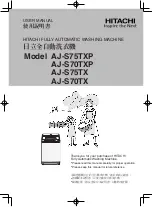
TP10313
PAGE 34
1.3 Slitting (Cutting) Sheets
Folders may be used to cut folded or flat sheets apart.
The general set up for blades and collars is shown in the
Figure 36. Two or more cuts may be made if duplicate sets
of slitters are used.
Be careful when mounting slitter blades to collars in
order to avoid ragged edges which can be caused by two
conditions:
1) Nicks or burrs on the collars or blades. Remove
carefully by filing or using a fine piece of emery cloth.
2) Incorrect mounting of blades caused by tightening
with the wrong type screw. Always use flat head screws on
the side of blades and blade holders which are countersunk.
Before tightening the blade to the collar, slide the blade
with the collar loosely attached on the end of the shaft. Then
tighten securely to align both blade and collar, and allowing
free horizontal movement. Place the blade on the upper
shaft in the position where the cut is to be made. Then move
the blade on the lower shaft so that the two blades are
pressed snugly together. Too much space between the blades
will produce a ragged cut.
Figure 36-1 shows a spacing washer mounted on the
outside of the blade for reinforcement. This helps prevent
bending or twisting when running very heavy work or any
job containing a large number of folds.
Space the pull out tires evenly to support the sheet.
Figure 36
Figure 37
Slitter Blades
Part # Description
06378 3/32" Thick Countersunk Flat Side
06804 3/32" Thick Countersunk Bevel Side
15240 .062 Thick Countersunk Flat Side
15241 .062 Countersunk Bevel Side
15573 Hollow Ground Countersunk Flat Side
15574 Hollow Ground Countersunk Bevel Side















































